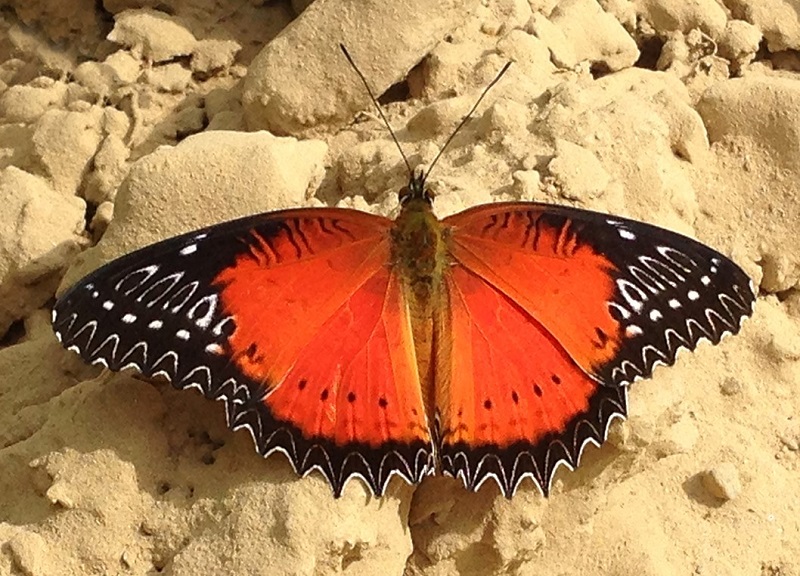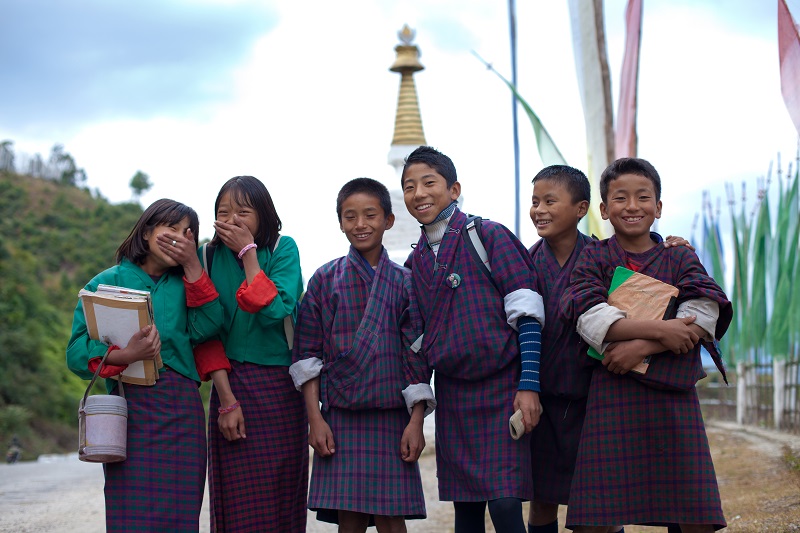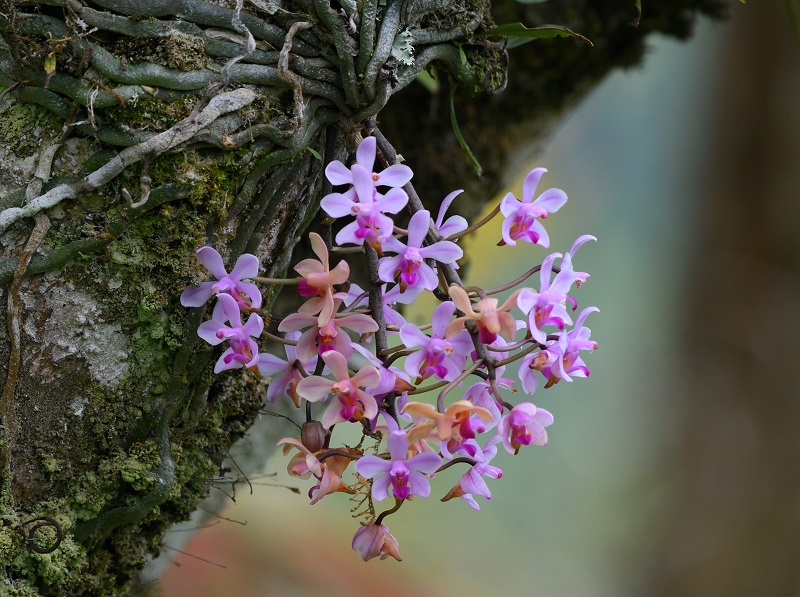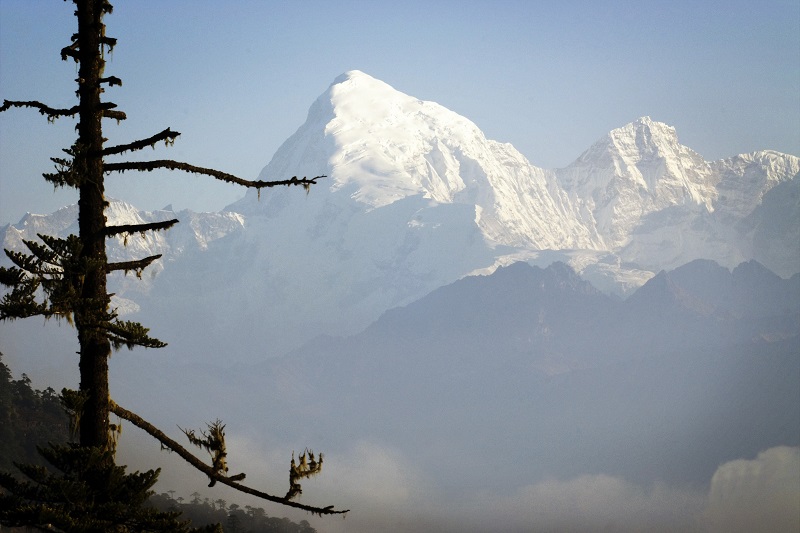Home | Tours | Trip Reports | News | Team | Calendar | Links | Contact | Store | Mailing List

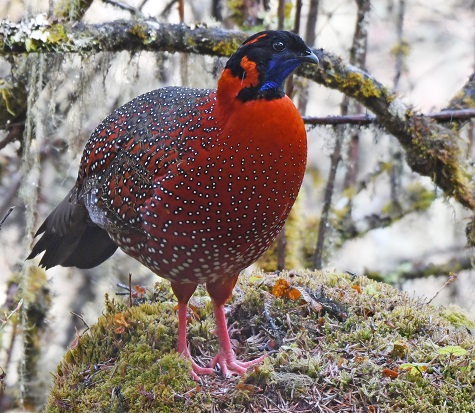 BHUTAN
BHUTANBirds & Culture
April 22 - May 7, 2027
Contact [email protected] to reserve your place!
Trip
Cost & Travel
Planning> Registration
Form>
Tour
Registration, Terms,
Cancellation Policies>
The Buddhist Kingdom of Bhutan lies on the eastern edge of the Himalayas and is known for its unique culture and dramatic landscapes. For birders, the "Land of the Thunder Dragon" holds prized avian specialties only attainable with a trip to this unspoiled country.
Bhutan has been protected by both its isolation within the Himalayas and the topography of its mountainous land, resulting in over 70% of the land remaining forested with approximately 25% protected by 10 National Parks and Wildlife Sanctuaries.
The diverse range of environments varies from sub-tropical at 150m to alpine over 4,500m, supporting a natural habitat and wide range of eco-systems with rich and varied bird-life, flora and fauna. There are many unique species to see in Bhutan (300-350 species on this tour) as well as rare mammals, flowers, butterflies and more.
Join Sunrise Birding along with expert local guides on a breathtaking journey through the astonishing ecological and cultural tapestry of the Himalayan Kingdom of Bhutan.
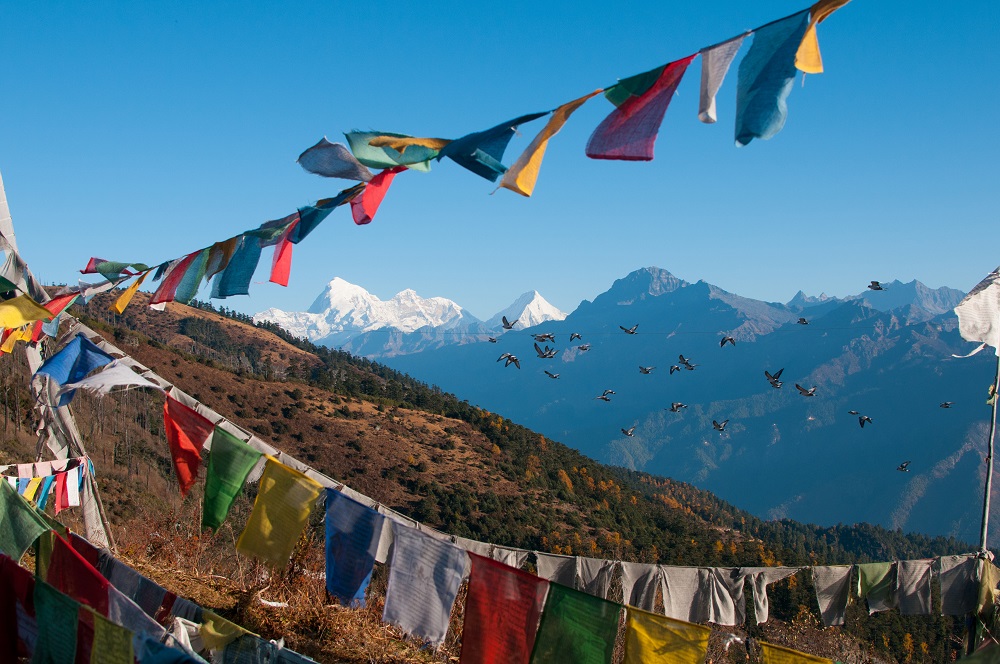
INTENDED ITINERARY - We strive to provide the best itinerary and program for our guests. However,
please be aware that the itinerary may be subject to change due to unforeseen
circumstances beyond our control. We reserve the right to modify the itinerary as
necessary. Rest assured, we will notify you of any changes in advance, if applicable.
Day 01: Flight from Delhi to Guwahati and drive to Samdrup Jongkhar
Welcome to Bhutan!
Plan on being in Delhi the night before Day 1 so that you can meet our group and guides at the airport for the drive to Samdrup Jongkhar (3 hours). Along this drive keep an eye out in the fields for the
rare Lesser and Greater Adjutants, Little Cormorant, and White-throated Kingfisher. Your
Bhutanese hosts will greet you at the Bhutan gate in Samdrup Jongkhar and take you to
our hotel for your first night in Bhutan.
After checking into the hotel, as time allows we will bird in the surrounding area looking for Indian and Chinese Pond Herons, Little Heron, Little and Cattle Egrets, Asian Pied Starling, Common Myna, Rose-ringed and Alexandrine Parakeets, Common Tailorbird, Oriental Magpie Robin, Yellow-footed Green Pigeon, Black-hooded Oriole, Common Iora, Green Bee-eater, Dark-rumped Swift, Black-backed Forktail, and with a bit of luck the very rarely seen Blyth’s Kingfisher. NIGHT: Norbu Khangsa, Samdrup Jongkhar (300m).
Day 02: Birding in and around Samdrup Jongkhar for tropical species
Today we will spend time exploring the tropical forest between Samdrup Jongkhar and
Deothang. Here we will look for species such as Ruby-cheeked Sunbird, Little
Spiderhunter, Pied Harrier, Hooded Pitta (rare), Golden-fronted Leafbird, Asian
Paradise Flycatcher, Blue-eared, Coppersmith and Lineated Barbets, Greater Racket-tailed Drongo, Green-billed Malkoha, Scaly Thrush, Long-tailed Sibia, White-rumped
Shama, Thick-billed Warbler, Stripe Tit and Grey-throated Babblers, Black-naped
Monarch, Asian Fairy Bluebird, Dollarbird, Oriental-pied, Wreathed and Great Hornbills, Violet Cuckoo, Collared Scops Owl, Slaty Blue and Red-throated Flycatchers,
Large-tailed Nightjar, Long-tailed Broadbill, and Puff-throated Babbler.
NIGHT: Norbu Khangsa, Samdrup Jongkhar (300m).
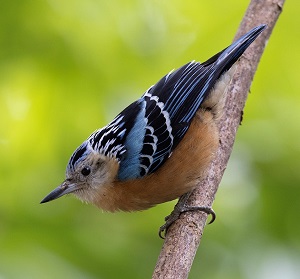 Day 03: Deothang to Trashigang, birding en-route
Day 03: Deothang to Trashigang, birding en-route
We will start early to get to Morong Valley where we will bird these superb forests with opportunities to study birds such as Blyth’s Shrike Babbler, Himalayan Cutia, Rusty-fronted Barwing, Long-tailed Sibia, Beautiful Nuthatch (rare and only few known sites in Bhutan), Red-tailed and Blue-winged Minlas, Hill Partridge, Kalij Pheasant, Bay and Crimson-breasted Woodpeckers, Greater and Lesser Yellownapes, Golden-throated
and Great Barbets, Mountain Tailorbird, Red-headed Trogon, Himalayan Swiftlet,
Fork-tailed and House Swifts, Collared and Asian Barred Owlets, Wedge-tailed Green
Pigeon, Eurasian Sparrowhawk, Besra, Northern Goshawk, Steppe and Bonelli’s Eagles, Orange-bellied Leafbird, Long-tailed and Grey-backed Shrikes.
After breakfast, we will continue our birding while enjoying the spectacular view of the hills, isolated farms and tiny hamlets on the route to Trashigang. Species we may encounter include Yellow-billed Blue Magpie, Grey Treepie, Eurasian Jay, Large-billed Crow, Maroon Oriole, Long-tailed Minivet, Yellow-bellied and White-throated Fantails, Ashy and Black Drongos, Blue Whistling Thrush, Long-billed Thrush (rare), Ultramarine, and Little Pied flycatchers, Large and Rufous-bellied Niltavas, Spotted Forktail, Common Stonechat, White-tailed Nuthatch, Fire-capped, Green-backed, Black-throated and Rufous-fronted Tits, Striated, Mountain, Black and Red-vented bulbuls, Aberrant Bush Warbler, Ashy-throated, Chestnut-crowned and Lemon-rumped Warblers, Striated, White-throated and Chestnut-crowned Laughingthrushes, Rusty-cheeked and Streak-breasted Scimitar Babblers, Rufous-throated Babbler, Maroon Accentor (rare), Yellow- breasted Greenfinch and Tibetan Siskin. NIGHT: Lingkhar Lodge, Trashigang, (1100m).
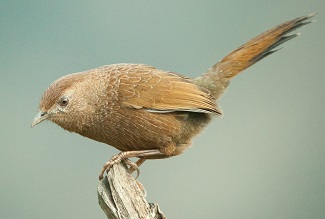 Day 04. Trashigang over Kore La (2,450m) to Yongkola, Mongar, birding en-route.
Day 04. Trashigang over Kore La (2,450m) to Yongkola, Mongar, birding en-route.
We will leave Trashigang after and early breakfast and drive down to Chazam. The journey continues
through Sherichhu from where the road climbs through the Yadi Loops, in just 10 kms! From here we continue to the little village of Yadi. The road passes fields of corn and broad-leaf forests where we will stop and bird before our final ascent to Kore La 2,450m. Here, among other species, we may find: Brown Bullfinch, Scarlet Finch, Grey-winged Blackbird, Brown-throated Treecreeper, and
Grey-sided Laughingthrush.
Crossing the pass, we descend through cool broad-leaved trees, dripping with exotic orchids, fern-lined forests of rhododendrons, where again we will stop to bird hoping to see in these pristine environs: Maroon Oriole, Common Rosefinch, Hill Prinia, Fire-capped Tit, Bhutan Laughingthrush, Rufous-bellied Woodpecker, Asian Barred Owlet, Gold-naped Finch, Kalij Pheasant and Barn Swallow.
Back in the vehicles, we continue our descent to the town of Mongar and on to the sub-tropical forests around Lingmethang at 650m. From here superlatives continue to describe the journey as we begin our climb to the broad leaf forests at Yongkola 1,700m where we will stay for 3 nights. NIGHT: Trogon Villa, Yongkola (1,700m).
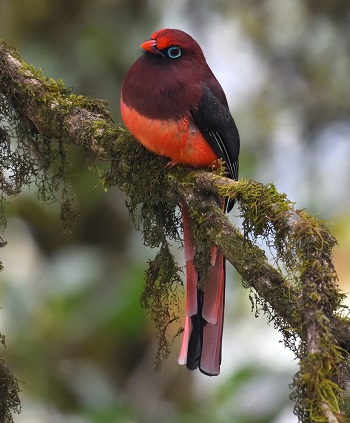 Day 05, & 06: Yongkola and Sengor birding hotspots
Day 05, & 06: Yongkola and Sengor birding hotspots
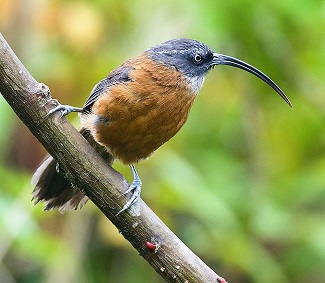 The warm broadleaf forests provide the perfect environment for many avian species
including many of Bhutan’s sought-after birds. And so we will spend two full days
birding in the upper and lower Yongkola region. In this breathtaking landscape, we will bird in a protected area of pristine forests using a paved yet rarely used road, providing the ultimate beneficiary birding opportunities. It is here in this birding hotspot that we can look for Ward’s Trogon (rare), Slender-billed Scimitar-Babbler and Rufous-throated Wren Babbler (a little known and endangered species), Black-headed Shrike Babbler (rare and the only known site for Bhutan), Satyr Tragopan (rare), Bar-winged Wren Babbler, Blue-winged Laughingthrush, White-breasted Parrotbill, and perhaps Gould’s Shortwing!
The warm broadleaf forests provide the perfect environment for many avian species
including many of Bhutan’s sought-after birds. And so we will spend two full days
birding in the upper and lower Yongkola region. In this breathtaking landscape, we will bird in a protected area of pristine forests using a paved yet rarely used road, providing the ultimate beneficiary birding opportunities. It is here in this birding hotspot that we can look for Ward’s Trogon (rare), Slender-billed Scimitar-Babbler and Rufous-throated Wren Babbler (a little known and endangered species), Black-headed Shrike Babbler (rare and the only known site for Bhutan), Satyr Tragopan (rare), Bar-winged Wren Babbler, Blue-winged Laughingthrush, White-breasted Parrotbill, and perhaps Gould’s Shortwing!
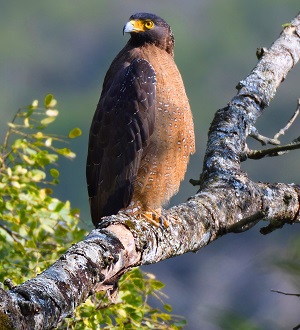 After birding the upper elevations above Yongkola, acknowledged as being one of the great birding roads of the world, we will slowly descend to Yongkola at approximately 1700m. We have time to explore the wonderfully rich, subtropical, warm and cool, broad- leaved forests along the lower section of this road where ancient trees
are festooned with orchids adding a riot of color to this verdant land. Trails crisscross the forests, but few birders venture far into their depth consequently, exactly what avian delights may be around the corner may be a complete surprise. Here we should encounter Hill, Rufous-throated and Chestnut-breasted Partridges, Rufous-bellied and Crested Serpent Eagles, the rare Rufous-necked Hornbill (the forests of Bhutan are the stronghold for this impressive species), Speckled Wood-Pigeon (another rare bird), Blue-bearded Bee-eater and two of the Himalayas’ rarest birds, the cobalt Blue-fronted Robin, and the elusive and strange Wedge-billed Wren Babbler.
After birding the upper elevations above Yongkola, acknowledged as being one of the great birding roads of the world, we will slowly descend to Yongkola at approximately 1700m. We have time to explore the wonderfully rich, subtropical, warm and cool, broad- leaved forests along the lower section of this road where ancient trees
are festooned with orchids adding a riot of color to this verdant land. Trails crisscross the forests, but few birders venture far into their depth consequently, exactly what avian delights may be around the corner may be a complete surprise. Here we should encounter Hill, Rufous-throated and Chestnut-breasted Partridges, Rufous-bellied and Crested Serpent Eagles, the rare Rufous-necked Hornbill (the forests of Bhutan are the stronghold for this impressive species), Speckled Wood-Pigeon (another rare bird), Blue-bearded Bee-eater and two of the Himalayas’ rarest birds, the cobalt Blue-fronted Robin, and the elusive and strange Wedge-billed Wren Babbler.
Other regularly seen species include, Bay and Lesser Yellownape, Golden-throated and Blue-throated Barbets, Large Hawk and Himalayan Cuckoos, Collared Owlet, Grey Treepie, Gray-chinned, Short-billed and Long-tailed Minivets, Yellow-bellied Fantail, Blue-capped Rock Thrush, Verditer Flycatcher, Large Niltava, Hodgson’s Redstart (in farmland at the edge of the forest), Plumbeous Redstart (males can be seen vigorously defending streamside territories), Slaty-backed Forktail, Rusty-flanked Treecreeper, Sultan, Black-throated, Rufous-fronted, Yellow-browed and Yellow-cheeked tits, Mountain and Ashy Bulbuls, Hill and Striated Prinias, Chestnut-headed, Slaty-bellied and Gray-bellied Tesias, Gray-sided Bush Warbler, Gray-hooded, White-spectacled, Chestnut-crowned, Broad-billed and Black-faced warblers, White-crested, Striated, Rufous-necked, Gray-sided, and Blue-winged Laughingthrushes, Coral-billed Scimitar-Babbler, Rufous-capped and Golden Babblers, Red-billed Leiothrix, White-browed and Black-eared Shrike Babblers, Rusty-fronted Barwing, Chestnut-tailed and Red-tailed Minlas, White-naped, Whiskered, and Black-chinned Yuhinas, and the exquisite Golden-breasted and Yellow-throated Fulvettas (virtually unknown elsewhere), Fire-breasted Flowerpecker, Crimson-browed Finch, Spot-winged Grosbeak, and Scarlet Finch (again, incredibly beautiful males).
One morning we will rise early to drive to Sengor for the early morning birding, here we will look for the rare Satyr Tragopan and the Bar-winged Wren Babbler among commoner species such as Gray-crested, Coal, Green-backed, Yellow-browed and Black-browed Tits, Mrs. Gould’s, Green-tailed and Fire-tailed Sunbirds, Rufous-gorgeted Flycatcher, Ashy-throated, Lemon-rumped, Large-billed and Blyth’s Leaf-Warblers, White-browed and Rufous-winged Fulvettas, Stripe-throated Yuhina, Fire-tailed Sunbird, White-throated Redstart and Green Shrike Babbler. NIGHTS: Trogon Villa, Yongkola (1,700m).
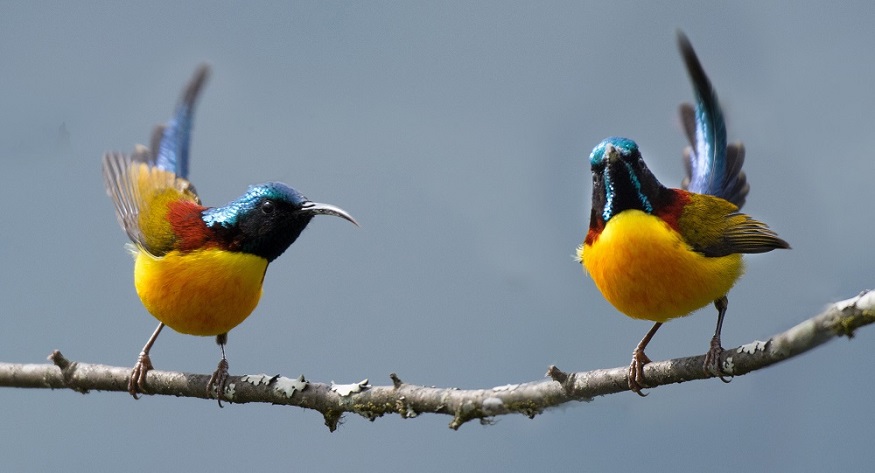
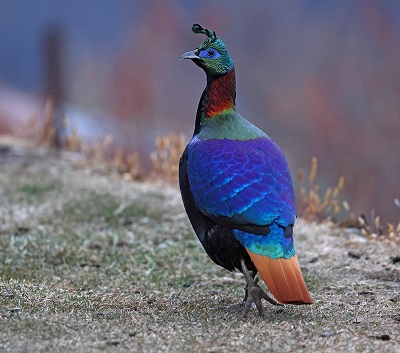 Day 07: Yongkola to Bumthang. Birding along Thrumshing La National Park
Day 07: Yongkola to Bumthang. Birding along Thrumshing La National Park
We will bird along the upper Yongkola region before breakfast after which we will drive up to the high pass of Thrumshing La at 3,799 m, where we have breathtaking views of the eastern Himalayas. As we drive up to the pass we will stop at key locations for birding, looking for Himalayan Buzzard, Mountain Hawk-Eagle, Great and Fulvous Parrotbills, Chestnut-bellied Rock Thrush, White-collard Blackbird, Himalayan Bluetail, White-browed Bush Robin, Blue-fronted Redstart, Eurasian and Rusty-flanked
Treecreepers, Hume’s Bush Warbler, Black-faced and Spotted Laughingthrushes, Red
Crossbill, Red-headed Bullfinch, White-winged Grosbeak, Eye-browed, Dusky, and
Dark-throated Thrushes.
From the pass we descend through forests of towering hemlocks,
spruce, Silver fir and larch which are particularly good for species like Himalayan Monal, Blood Pheasant, and Satyr Tragopan. We travel through the picturesque village of Ura to Bumthang and our hotel for the night. NIGHT: Kailas Guesthouse, Bumthang, (2,600m).
Day 08. Bumthang to Trongsa birding along Yotong La
After a hot drink we will leave early in order to drive through the pine forests, cross the
Chumey Valley to Gyeltsha, from here we will take a short de-tour to Tharpaling
monastery where we look for Himalayan Monal, Blood Pheasant and Satyr Tragopan.
After having breakfast we will make our way back to the main road and on to Yotong La
at 3, 353m. From the pass we will slowly descend down through mix rhododendron
forest where we will look for, Fire-tailed Myzornis, Chestnut-headed Tesia, Rufous-vented Yuhina, Black-faced Laughingthrush, Yellow-bellied Flowerpecker, Darjeeling
Woodpecker and White-winged Grosbeak, Great and Brown Parrotbill, Red-headed
Bullfinch, Stripe-throated and Whiskered yuhinas.
In the afternoon we will drive towards Shemgang Road for more birding before checking into our hotel in Trongsa. Along this stretch we should encounter, Spotted Forktail, Bhutan Laughingthrush (the only near endemic bird of Bhutan), Elachura, Himalayan Cutia, Streak-breasted Scimitar Babbler, Barred Cuckoo Dove, Greater Yellownape, Steppe Eagle, Tibetan Siskin, Large Niltava, and Black-eared Shrike Babbler. NIGHT: Tendrel Resort, Trongsa, (2,200m).
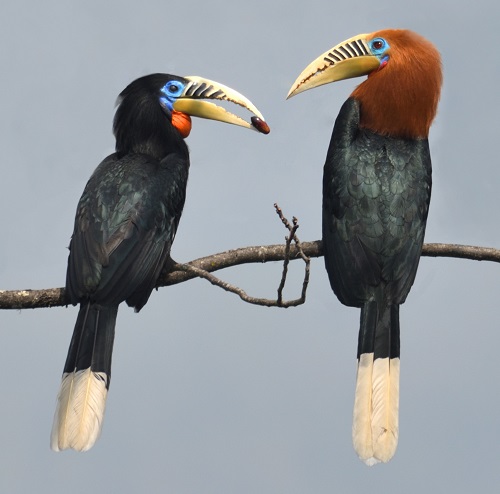 Day 09: Trongsa to Tingtibi via Shemgang. Birding along Chunjey Pang,
Dangdung, Koshala and Dakphai Roads.
Day 09: Trongsa to Tingtibi via Shemgang. Birding along Chunjey Pang,
Dangdung, Koshala and Dakphai Roads.
We rise early to bird the famous Shemgang road making our first stop at Chunjey Pang
where we should encounter Eurasian Jay, Pale Blue Flycatcher, Greater Yellownape,
Hill Prinia, Large Niltava, and the beautifully plumaged Blue-capped Rock Thrush.
After a hot picnic breakfast we continue our drive to Dangdung 740m, stopping briefly at Kuenga Rubten, the former Summer Palace of the Second King. Continuing our descent through the intensely cultivated, terraced fields, we should see Crested Bunting, Striated Prinia and Striated Yuhina.
From Dangdung we will climb up to Koshala, where amongst the flowering trees, we should encounter Crimson Sunbird, Tickell’s Leaf Warbler, Lemon-rumped Warbler, Blue-throated Barbet, Rufous Woodpecker, Large Hawk Cuckoo, and our first of the many chance to see the rare Rufous-necked Hornbill.
Approaching Tingtibi in the warm broadleaf forest we should find species such as: Lesser Racket-tailed Drongo, Ashy, White-throated and Black-crested bulbuls, Fulvous-breasted Woodpecker, Streaked Spiderhunter, Lesser-necklaced Laughingthrush, Pin-tailed and Wedge-tailed Green Pigeons, Rufous-necked Hornbill, Common Green Magpie, and Emerald Dove. NIGHT: Hotel Twang, Tingtibi, (700m).
Day 10. Exploring the sub-tropical forests of Tingtibi (Royal Manas National Park)
Today we will explore in and around Tingtibi and Shemgang as we have lots of target
birds to look for. The magnificent and very rarely visited Shemgang Road is one of the
most beautiful and peaceful roads in the world, with similar elevations to the now
famous Lingmethang Road, we can see an amazing variety of rare and special birds as
well as the Golden Leaf Monkey (langur), which can be seen often as it is their prime
habitat. Some of the target birds for the day include Rufous-throated and Chestnut-breasted Partridges, Gray Peacock-Pheasant, Barred Cuckoo Dove, nine species of
cuckoos, Blue-bearded Bee-eater, the amazing Rufous-necked and Great Hornbills,
White-browed Piculet, Bay Woodpecker, Long-tailed Broadbill, White-tailed Robin,
White-browed Scimitar Babbler, the stunning Cutia, Lesser Necklaced, Rufous-vented
and Blue-winged Laughingthrushes, Rufous-winged
and Nepal Fulvettas, White-naped, Black-chinned and White-bellied Yuhinas, Sultan
Tit, and hopefully Lesser Rufous-headed Parrotbill, Long-billed Wren Babbler, Green
Cochoa, White-hooded Babbler (rare and the only known site for Bhutan), and the rare
Beautiful Nuthatch. In our past trips Rufous-necked Hornbills have occasionally flown
over our hotel and at one time three perched on a tree nearby giving us lengthy,
stunning views of this magnificent bird.
NIGHT: Hotel Twang, Tingtibi, (700m).
Day 11: Tingtibi to Trongsa via Shemgang. Birding along Dakphai Road
Today we will start early to get to the habitat of the Beautiful Nuthatch, allowing
ourselves plenty of time to locate and see this amazing bird. It has been regularly
recorded on our past trips and we hope to repeat our sightings this spring. After a hot
breakfast eaten in yet another stunning location, we will continue birding along the
Shemgang road, stopping at the prime locations to bird. As we drive to Trongsa there
are amazing views all along the road and the occasional waterfall gushing its way down
the mountain slopes. We will stop for lunch at Kosha La from where we have an amazing
view of the valley below.
Just before arriving in Trongsa we will pass high cliff-faces where we will stop to look for the Yellow-rumped Honeyguide among the cluster of beehives clinging to the rock face and in the nearby waterfall we will look for the regularly seen Little Forktail. NIGHT: Tendrel Resort or similar, Trongsa, (2,200m).
Day 12. Trongsa to Phobjikha
The first part of the morning is spent birding along the Trongsa-Chendibji stretch looking for
Brown Dipper, Crested Kingfisher, Fire-tailed Myzornis, and Yellow-browed Tit. After a
hot picnic breakfast, the road will take us through the village of Chendibji where we will
stop near the Nepalese styled Chorten, picturesquely situated alongside the river. After
a short break at the stupa, we will continue our journey through Chazam villages before
climbing to Pele La (3,350m) for stunning views of the valleys, hills and mountain ridges
leading you up to Mt Kangbum and Jichu Drake. A short break whilst we soak up the
view, before descending through forests of rhododendron and fir, to the Phobjikha
valley.
NIGHT: Gakiling Guesthouse, Phobjikha (2,800m).
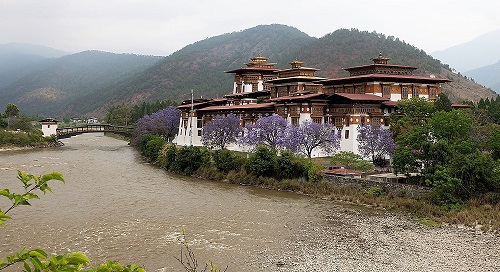 Day 13. Phobjikha to Punakha. Birding at Pele la pass and
Nobding valley, Punakha Dzong.
Day 13. Phobjikha to Punakha. Birding at Pele la pass and
Nobding valley, Punakha Dzong.
We will start early in the morning to reach Pele la pass for some high-altitude birding,
species we may find include Himalayan Monal, Satyr Tragopan, Fire-tailed Myzornis,
Himalayan Vulture, Snow Pigeon, Stripe-throated and Rufous-vented Yuhinas, Dark-breasted Rosefinch, Altai Accentor, and more.
After breakfast we will descend down to lower Nobding valley where we scan the
broad-leaved forest looking for special birds such as Ward’s Trogon, Himalayan Cutia,
Long-billed Thrush, Himalayan Cuckoo, Spotted Forktail, Striated Laughingthrush, and
more.
Arriving in Punakha we will visit the magnificent Punakha Dzong followed by some birding along the Puna Tsang Chhu River for some waterbirds before calling the day. NIGHT: Meri Puensum Resort, Punakha (1300m).
Day 14. Punakha to Paro birding along Dochu La (3,150m) road.
This morning we leave the terraced fields and sub-tropical forests around Punakha and
travel to Royal Botanical Park at Lampelri, which forms one of the critical biological
corridors connecting the Jigme Singye Wangchuck National Park and the Jigme Dorji
Wangchuck National Park. It has cool broad leaf forests, mixed conifer forests, fir and
sub-alpine forests and a temperate rain forest with hundreds of species of flora and
fauna.
Continuing to Dochu La, we have an awe-inspiring sight with the road festooned with
prayer flags and 108 chortens. From here on a clear day, there are magnificent
panoramic views of the high Himalayas, including Gangkar Puensum - the highest peak in Bhutan at 7,497m. We'll look for the Great Parrotbill here as well as Spotted Laughingthrush and others. From the pass
we drive down to Thimphu where we will stop by a marshy land near Babesa looking for
Black-tailed Crake.
Night: Hotel Olathang,
Paro, (2300m).
Day 15. Hike up to the Tiger’s Nest Monastery (approx 5 hrs walk). Birding en-route.
Today you will have a fabulous last day in Bhutan with a great mix of birding and some
of the Paro Valley's cultural treasures. The cultural highlight will be the walk up to the
famous Tiger's Nest, Taksang Monastery. The monastery is perched some 600m up on a
cliff overlooking the valley and was said to be where the legendary Indian saint, Guru
Padma Sambhava, flew from East Bhutan on the back of a tiger to defeat demons who
were opposing the spread of Buddhism in Bhutan. It is a steep uphill walk through
woods, of about 1½-2hrs, to reach a tea house (an ascent of 340m).
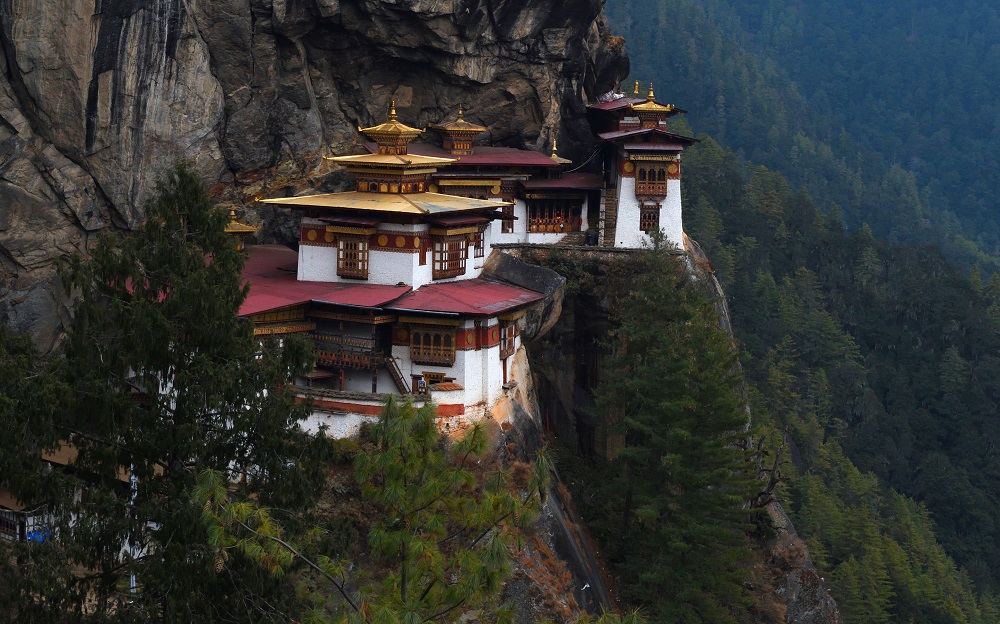
After a welcome
refreshment at the tea house, one of the principle viewpoints of the monastery you will
climb the further half hour’s ascent, which brings you to another viewpoint directly
across from the monastery. The final section of the walk takes you from this viewpoint
steeply down 100m into the gorge that separates you from the monastery and then
climbs back up again to reach the monastery. You will then descend back to the valley
floor by your outward route back to where your vehicle will be waiting. The full walk to
the monastery and back involves approximately 740m of ascent.
Along this hike we will look for, Green-backed, Coal and Grey-crested tits, White-tailed Nuthatch, Yellow-billed Blue Magpie, Spotted Nutcracker, Black-faced, Chestnut-crowned, White-throated and Spotted Laughingthrushes. Up at the monastery by the rocky ledges we will scan for flocks of Snow Pigeon and Alpine Accentor while the waterfall next to the monastery often gives us the opportunity to see Little Forktail, White-capped and Plumbeous Redstarts. Night: Hotel Olathang, Paro, (2300m).
Day 16: Departures
After breakfast, we will take a short 15-minute drive to Paro Airport and catch our flight to Delhi for your onward connection.
ROUTE MAP
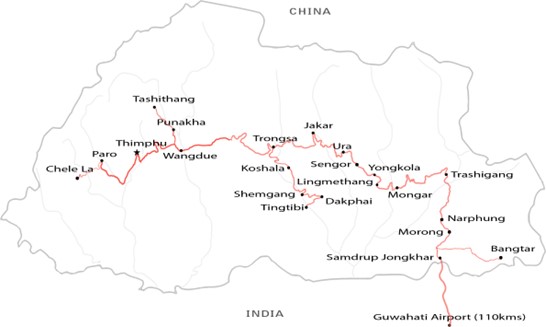
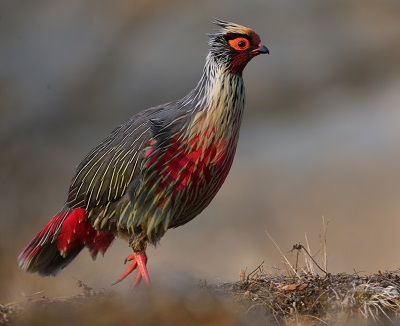 BHUTAN! BHUTAN!April 22 - May 7, 2027 Contact [email protected] to reserve your space! Registration Form> TOUR
PRICE: $8295.00 per person based
on
double
occupancy
and
a minimum
of
6
travelers
from
Delhi, India Deposit: $1000.00
per person
per tour.
Note:
Tour deposits
can be
paid by
credit
card via
PayPal.
Use this link to
make your credit card payment. Please
advise [email protected]
when you have made payment. Included in cost: All accommodations, meals, and guide services as stated in the itinerary, private ground transportation during the tour, Bhutan Visa Fee, Tea/coffee and snacks, Bottled water throughout the trip, All entrance fees for parks and nature reserves Not included: International round-trip flights to Delhi from home, travel insurance, excess baggage charges, private excursions, à la carte dishes, tipping for drivers and guides, snacks, drinks, laundry, telephone calls and anything else of a purely personal nature. Also, any and all costs arising from illness or Covid-19 related issues are not included in the tour cost and are the sole responsibility of the traveler. These include, among others, the costs of medical treatment, hospitalization, medical fees, transport, meals and accommodation in case of illness or quarantine, and the costs of any Covid tests needed before, during and after the tour.
Once
the tour is
confirmed to
go ahead, we
will send you
information
about booking
your flights.
**Please
note: Tour prices
are based on
quoted costs
from ground operators
(in their local
currency), estimated
fuel costs, and
the rate of exchange
the time of itinerary
publication.
The erratic nature
to global financial
markets makes
it difficult
to predict changes
in costs and
foreign currency
exchange rates
over the long
term. Since tours
are priced well
in advance of
the actual operation
of the tour,
tour costs, fuel
costs and exchange
rates can change,
sometimes drastically.
Depending on
the extent of
such changes,
it may be necessary
to implement
a surcharge on
this tour. If
a surcharge is
necessary, every
effort will be
made to minimize
the amount. Cancellations
and Refunds:
TRIP INSURANCE: PLEASE NOTE:
|
